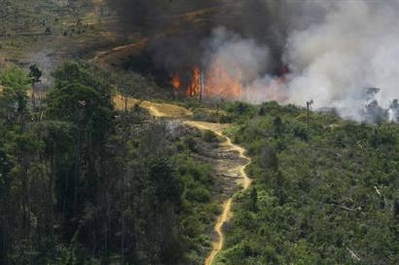
Share
Lowlands Multi-Sectoral Development and Restoration Options Analysis in Indonesia
CHALLENGE
Indonesia’s persistent fire and haze crises undermine the country’s economic gains and disproportionately affect the poor. Most fire-associated haze stems from the development of forested peat swamps in the lowland areas of Sumatra, Kalimantan and Papua, mostly for the conversion of land to plantations for oil palm or pulp and paper. Between June and October 2015, more than 100,000 human-induced fires burned 2.6 million hectares of land, with an estimated economic cost of IDR 221 trillion (USD 16.1 billion), equivalent to 1.9 percent of 2015 GDP and more than twice the reconstruction cost after the Aceh tsunami (World Bank, 2016). The haze associated with the fires covered large parts of Indonesia, Malaysia and Singapore, resulting in air quality as much as five times worse than in the world’s most polluted cities.
The Government of Indonesia has taken action in an attempt to address these issues, including launching a Peatland Restoration Agency and placing a moratorium on new licenses for peatland development with a ban on any new clearing, draining or conversation of unopened peatlands. However, this approach currently lacks a unified program and strategy, compounded by fragmented institutional responsibilities. There is a clear need for improving decision making on the most effective and efficient ways to transition away from an unsustainable model of lowland development.
APPROACH
This activity aims to assist the Government of Indonesia in formulating a sustainable and socially inclusive strategy and action plan to restore, manage and develop lowland areas prone to fire and haze. The outcomes are expected to alleviate poverty, enhance food security, and reduce economic costs from forest fires, subsidence and flooding. The work will be carried out in three phases:
- Situation Assessment to bring together the existing information and Network Mapping and Financial Networks to help understand, visualize, and position the proposed analysis within broader political economy considerations
- Thematic Input Papers will explore a range of technical themes to inform the formulation of specific development scenarios (such as agriculture and employment; supply chains associated with key commodities; and social assessments), while a Development Scenarios Report will summarize potential development spaces related to lowland areas in Sumatera, Kalimantan and Papua.
- An Options Assessment will detail the various possibilities that could be implemented to achieve the desired vision or development scenario, accompanied by an Action Plan.
RESULTS
This activity is ongoing. However, preliminary findings are show that:
(i) Flooding in SUMSEL is severe and elevations are already often below high tide.
(ii) there are already large areas of food and plantation crop failure likely due to periodic inundation.
(iii) future projections of peatland subsidence and sea level rise are likely to reveal a dire situation with significant land areas vulnerable to regular, severe flooding.
This strongly supports the anticipated outcomes according to the original concept: “to assist with the process of changing trajectories for development of the lowland areas of Indonesia and the protection of peat forests.” In addition to widely publicized consequences of forest fires and greenhouse gas emissions from peatland conversation, this study will equip policy makers with another important resource on evaluating the consequences of current land and water management paradigms.
Currently, many stakeholders will claim that, if they prevent forest and land fires, current development paradigms are acceptable to facilitate Indonesia’s required economic growth. However, this activity will demonstrate that fire prevention is not enough. Land and water management also needs to be seriously evaluated and reformed.
More findings will be shared on this page when they become available.
For stories and updates on related activities, follow us on twitter and facebook, or subscribe to our mailing list for regular updates.
For stories and updates on related activities, follow us on twitter and facebook , or subscribe to our mailing list for regular updates.
Last Updated : 06-16-2024








